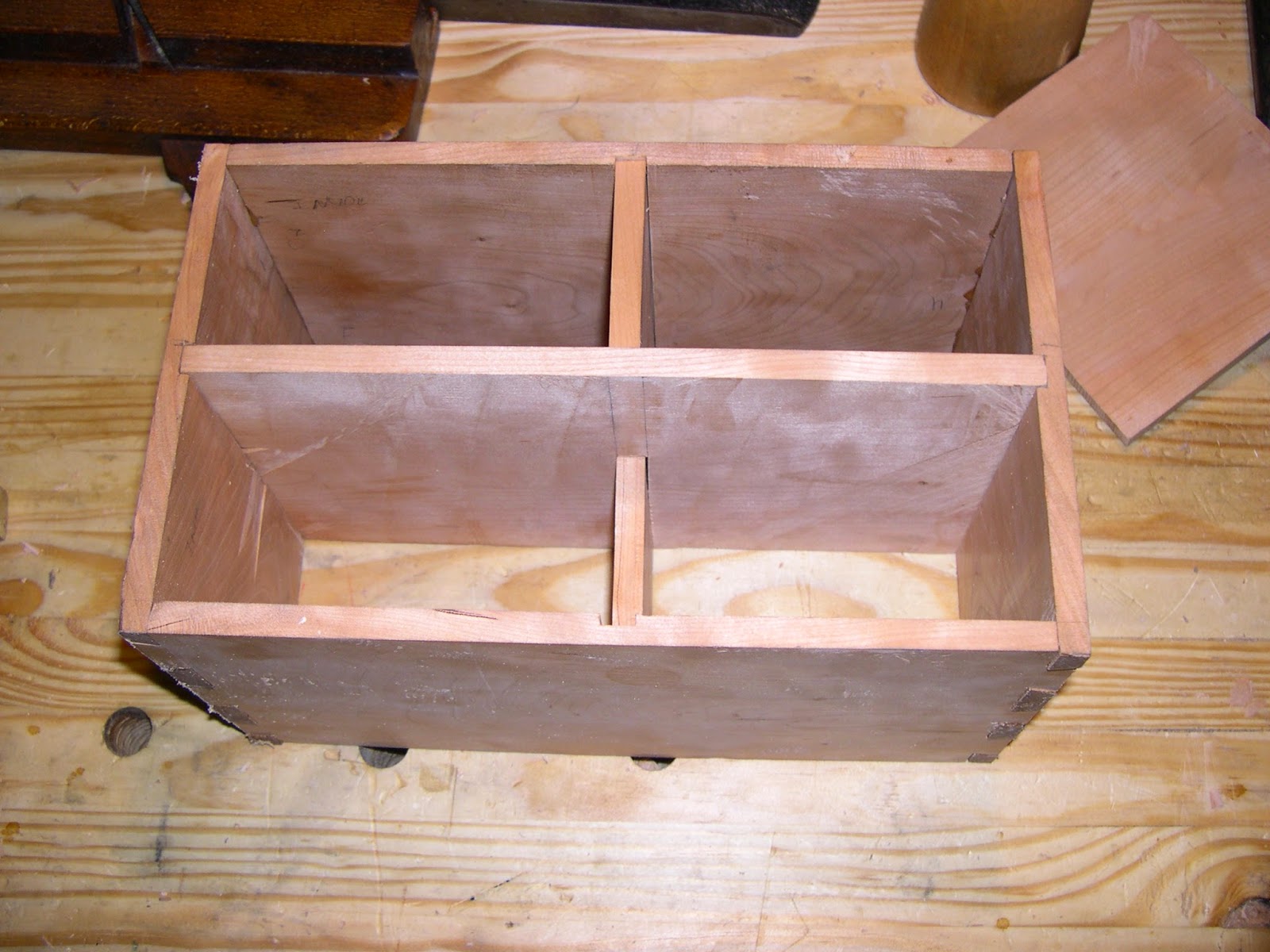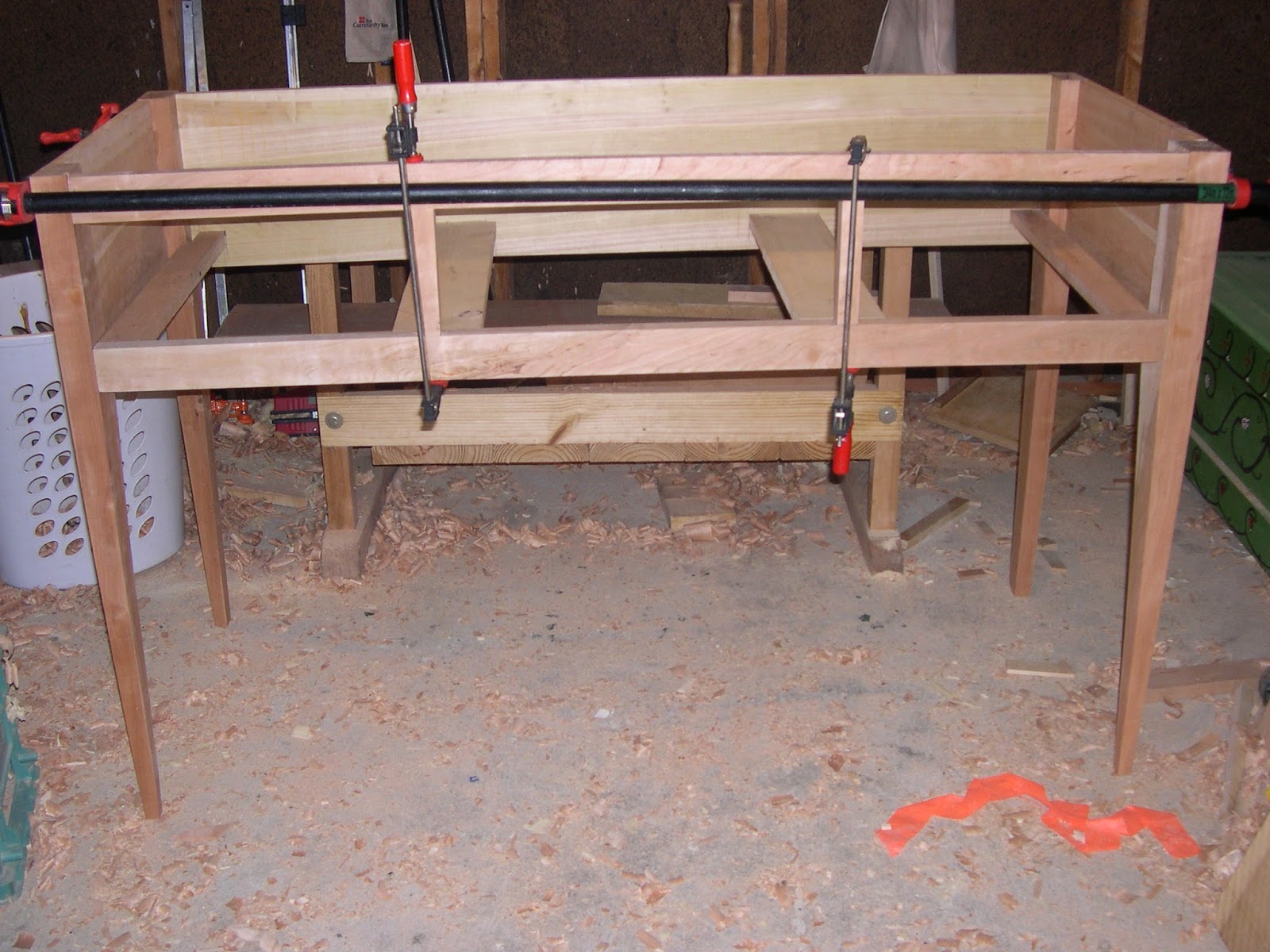I have no clue where the idea came from to build a sideboard. I think it was just the fact that we had more space than ever in our dining room and it looked fairly barren, coupled with the fact that we seemed to have an endless supply of dishes, silverware, stemware, and tablecloths. I'd purchased "Furniture in the Southern Style" almost a year ago to this date, and pored over the photos, drawings, and exploded diagrams of the different pieces from the MESDA collection. The one piece that I kept leafing back to was a simple three drawer sideboard with a back splash, some corbels around the front legs, and banding, constructed using mortise and tenon joinery.
I drew a design based off it, but stripped out the back splash, the corbels since they looked really clunky, and the banding because I wasn't sure how it would look against cherry (the original piece's primary wood is black walnut native to the southern USA. The secondary wood is southern yellow pine AKA longleaf pine).
I bought 47 bf of cherry and 10 bf of tulip poplar for the sideboard, based on calculating the bf requirements for the cutlist given in the MESDA book and then adding a little extra just in case. As it turns out, this was actually a little bit too much, and I wound up making a coffee table with the top and rails made out of the clearest and straightest cherry and using some left over white ash for the legs. I asked the guy who was selling me the lumber if he possibly had any leg blanks in the rough.
"Leg blanks? How thick do you need it?"
"Around 2 inches rough"
"No...I got a 10 foot slab of cherry 3 thick and 10 wide. Will that do it?"
And so I purchased a huge ass slab of wood that will give me hernia problems when I hit 40.
The first thing I did when I got the lumber was to pick out boards that were clear of knots, straight grained, and mostly flat. Unfortunately there were very few boards like that. What boards I did pick, I cut out drawer fronts, sides, and tops from. But because I used most of the flat and clear pieces of cherry for the coffee table I built, I had to go back to the lumber stacks and pick out some pretty crazy looking pieces of cherry that had some serious cupping.
The Legs
After I got my parts cut out, I started work on the legs. I'm not sure if you've had the pleasure of ripping 10 feet of 3 inch thick cherry, but it's the kind of pleasure that you want to reserve solely for a tablesaw or bandsaw. And because of the small, small size of my shop, I had neither. Just a lowly 700mm bowsaw with a 5 tpi web. After I cut the leg blanks out of the slab, I started work on them.
 |
| After mortising |
 |
| Tapered |
The tapers were done by using a drawknife to hog off waste. For something like this, though, there was a lot of material to take off. A hatchet or ax may have been a better choice. Mortises were cut with a 3/8" Narex mortising chisel which was a godsend. It's unique in that it's trapezoidal in cross section which allows you to better steer the chisel which is exactly what I needed in the wild figured cherry. The case sides are fairly wide, and more than likely the original side was one piece of black walnut, so to accommodate wood movement, I chopped the top mortise as the fitted mortise and left the bottom two a little longer than needed for their tenons and left them unglued. The reason is simple: if the wood attempts to contract, it'll be able to shrink on its lower half, and if it attempts to expand, it can do so on its lower half. Had I fitted the tenons tightly to the mortises and glued all three, when the side would try to expand or contract, it would split the sides.
The Sides and Back
After some serious handplaning, the case sides wound up being in the neighborhood of 12 inches wide. I used my dinky Stanley rabbet plane (the type with a one arm fence and depth adjuster that uses a lever instead of a nut and yoke) to cut rabbets to the proper tenon thickness, and then cut out the tenons from the one long rabbeted edge. Let's just say the Stanley leaves a lot to be desired when it comes to cutting rabbets. I now have my eye on the Lee Valley Veritas model. The back was done exactly the same way, but I mortised it for the drawer runners.
The Front Rails
The front rails were a nightmare. By this time, I was running fairly low on cherry. What were supposed to be the rails for the sideboard were now the rails for the coffee table. So I had to use some seriously twisted wood with crazy grain pattern. Grain run out, sapwood dispersed throughout, reversal, grain diving down, coming back up, undulating...it had it all!
 |
| Dry fitting to check the mortise and tenon |
 |
| Dry fit to test for square on the case front |
The Top
Because my best pieces went to the cherry coffee table, I settled for some lesser boards that had a lot of sapwood and a ton of warping. I did my best to flatten each piece, but after an hour I threw up my hands, and glued the three boards together. I think the real trick to getting flat panels from rough boards like this is to try and joint the edges so that the faces are approximately coplaner, and then roughly flatten the back face, and get the top dead flat and smooth from tear out. But now I know.
The Drawer Runners
This part wasn't too bad. After dry fitting the front rails I mortised the lower rail and cut tenons on some cherry off cuts and pine for the drawer runners. Looking back, it would've been much better to have had the side drawer runners as wide as possible so that they mated with the inside of the case sides. That would've made putting in drawer guides a cake walk, as I could've glued strips on the wide runner so that they butted up against the drawer. Because as of right now, my two outside drawers have no guides on their outer edges since their outer edges line up perfectly with the outer edges of the drawer runners.
 |
| At this point I should've said, "Hey wait a second..." |
The Glue Up
The glue up is the most exciting time of any project. It's the time when you're nearing completion, and it's also the time you'll most likely pay if you haven't done a dry fit, especially with larger pieces. After a particularly exciting glue up involving an out of square stool, a lone too long tenon for its mortise, a paring chisel, and my thumb, I always do dry fits to rehearse the best way to put the piece together and to find any mistakes while I can still fix them.
The Drawers
The drawers were constructed using half blind dovetails in the front and through dovetails in the back. I remember this being somewhat routine, although I wish I'd practiced dovetailing a lot more before jumping into the half-blinds. While I was chopping out the waste for the center drawer front, a large piece of cherry cracked out of the back despite my best efforts to use as little force as possible to chop the waste out and to keep the back well supported to prevent this from happening. But happen it did. I cut a triangular patch that was larger than the damage out of the drawer front, and cut a piece of veneer to cover it. I clearly hadn't had enough sleep the night before, since you should always cut the patch of veneer first, and then scribe the shape of the patch over the damaged area for a better fit.
The Finish
I finished the coffee table first before getting into the heavy work on this piece. But the thing that irritated me is that the garnet shellac over the cherry coffee table top looked really...orange. Not at all what I expected. I knew I'd have to stain the whole sideboard since all of the boards I'd used to build the top had cream colored sapwood in it, and the front rails were hideous with sapwood and crazy mineral streaks. I purchased red aniline dye from Lee Valley and applied it until I got the color mostly evened out. The top was the first part that I finished, using the French polishing technique and the same garnet shellac. The drawer fronts got the same treatment, and the rest was brushed with about 4 coats of garnet shellac. I used a card scraper to level the finish on the front legs, rails, and sides, and French polished on a small amount of shellac until I got the sheen I was looking for. The hardware was bought from Lee Valley.























































